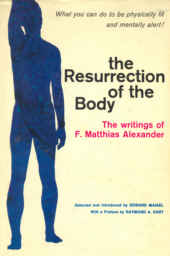During the heyday of pop therapies and bodywork in the 1970's, I was introduced to something
called the Alexander Technique, which was a curious combination of therapy and bodywork. Eventually
I found this landmark written by the originator of the technique. Here from the long Introduction by
Edwin Maisel is a concise summary of the technique:
[page xl] Mr. Alexander's technique unravels the kinks and complexes by a process
of positive replacement in which sound coordinations are built up with their
corresponding alterations in habitual sensory and emotional data, while at the best
the psychoanalysts merely untie a knot and leave the organic causes which
produced it untouched.
How does one go about this "positive replacement"? Inquiring minds and bodies want to know.
Alexander's point is that one must "stop oneself" from proceeding in the usual way, then proceed in the
new way one's Alexander teacher directs in a conscious way until the new way replaces the old,
dysfunctional way. This stopping, replacing, and moving into use of new ways of moving and being is
at the essence of the Alexander technique. The procedure is the process of new habit formation, which
can be considered to evolve over four distinct steps:
1. Unconscious Incompetence - you don't think of the new behavior, and can't do it.
2. Conscious Incompetence - you now think of the new behavior, and can't do it.
3. Conscious Competence - you think of the new behavior, and can do it.
4. Unconscious Competence - you don't think of the new behavior, and can do it.
In the Alexander technique, through the skilled intervention of a personal teacher (what now we call a coach), someone notices behaviors in you that are deemed dysfunctional and designs new behaviors. You are
then directed to perform the old behavior and when you do, you are told to "stop" and the new behavior
designed by the teacher is inserted in the place of the old. You perform the new behavior consciously
several times, and your coach monitors you for any relapses into old behavior. Soon the new behavior
becomes automatic.
An example in the beginning of Chapter Three tells of a little girl who was unable to walk
properly. Soon Alexander had her comparatively straightened out and able to walk without the twists
and distortions of earlier. His techniques of stopping the old patterns and manipulating the child into
the new postures and movements worked wonders where formerly all previous of her teachers had met
with failure.
[page 17] When this was done, the little girl looked across at her mother and said
to her in an indescribable tone, "Oh! Mommie, he's pulled me out of shape." . . .
In accordance with this poor child's judgment, her crookedness was straightness,
her sensory appreciation of her "out-of-shape" condition was that it was "in
shape." Imagine, then, what would be the result of her trying to get anything
"right" by doing something herself, as she had always tried and had always been
urged to try to do, whilst practising remedial exercises according to the directions
and under the guidance of a teacher. Small wonder that all attempts to teach her
had resulted in failure!





